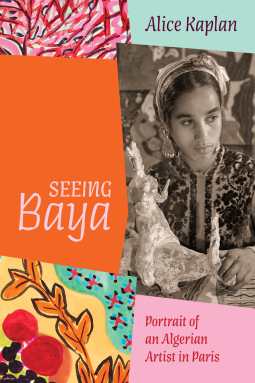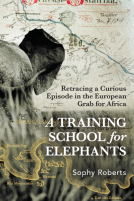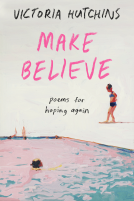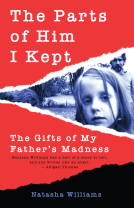
Seeing Baya
Portrait of an Algerian Artist in Paris
by Alice Kaplan
This title was previously available on NetGalley and is now archived.
Send NetGalley books directly to your Kindle or Kindle app
1
To read on a Kindle or Kindle app, please add kindle@netgalley.com as an approved email address to receive files in your Amazon account. Click here for step-by-step instructions.
2
Also find your Kindle email address within your Amazon account, and enter it here.
Pub Date Oct 15 2024 | Archive Date Oct 07 2024
Talking about this book? Use #SeeingBaya #NetGalley. More hashtag tips!
Description
On a flower farm in colonial Algeria, a servant and field worker known as Baya escaped the drudgery of her labor by coloring the skirts in fashion magazines. Three years later, in November 1947, her paintings and fanciful clay beasts were featured in a solo show in Paris. She wasn’t yet sixteen years old. In this first biography of Baya, Alice Kaplan tells the story of a young woman seemingly trapped in subsistence who becomes a sensation in the French capital, then mysteriously fades from the history of modern art—only to reemerge after independence as an icon of Algerian artistic heritage.
The toast of Paris for the 1947 season, Baya inspired colonialist fantasies about her “primitive” genius as well as genuine appreciation. She was featured in newspapers, on the radio, and in a newsreel; her art was praised by Breton and Camus, Marchand and Braque. At the dawn of Algerian liberation, her appearance in Paris was used to stage the illusion of French-Algerian friendship, while horrific French massacres in Algeria were still fresh in memory.
Kaplan uncovers the central figures in Baya’s life and the role they played in her artistic career. Among the most poignant was Marguerite Caminat-McEwen-Benhoura, who took Baya from her sister’s farm to Algiers, where Baya worked as Marguerite’s maid and was given paint and brushes. A complex and endearing character, Marguerite—and her Pygmalion ambitions—was decisive in shaping Baya’s destiny. Kaplan also looks closely at Baya’s earliest paintings with an eye to their themes, their palette and design, and their enduring influence.
In vivid prose that brings Baya’s story into the present, Kaplan’s book, the fruit of scrupulous research in Algiers, Blida, Paris, and Provence, allows us to see in a whole new light the beloved artist who signed her paintings simply “Baya.”
Available Editions
| EDITION | Other Format |
| ISBN | 9780226835082 |
| PRICE | $26.00 (USD) |
| PAGES | 176 |
Available on NetGalley
Featured Reviews
 Reviewer 860893
Reviewer 860893
“Seeing Baya” offers readers a captivating glimpse into the extraordinary life and artistry of Algerian artist Baya Mahieddine, whose talent and enigmatic persona left an indelible mark on mid-twentieth-century Paris.
In this illuminating biography, author Alice Kaplan skillfully unravels the fascinating narrative of Baya’s journey from humble beginnings on a flower farm in colonial Algeria to becoming a sensation in the vibrant art scene of Paris. Despite her young age, Baya’s remarkable paintings and clay sculptures captured the imagination of the French capital, earning her widespread acclaim and admiration from luminaries such as André Breton, Albert Camus, Henri Matisse, and Georges Braque.
Kaplan delves deep into the complexities of Baya’s life and the forces that shaped her artistic career, including her relationship with Marguerite Caminat-McEwen-Benhoura, whose mentorship and support were instrumental in Baya’s artistic development. Through meticulous research and vivid prose, Kaplan brings to life the vibrant cultural milieu of mid-century Paris and sheds light on the colonialist fantasies and political tensions that surrounded Baya’s rise to fame.
“Seeing Baya” not only celebrates the artistic legacy of a remarkable talent but also offers a nuanced exploration of identity, colonialism, and the enduring power of art to transcend boundaries. With its rich historical detail and compelling storytelling, this biography invites readers to rediscover the captivating work of an artist who defied convention and left an indelible impression on the art world.
 Reviewer 1256435
Reviewer 1256435
Seeing Baya is a book about Algerian artist Baya Mahieddine and her early life. I knew nothing about Baya or her art before picking up this book, despite her rubbing shoulders with artists like Matisse and Picasso.
Her life, like many servant girls in colonies, is marred by tragedy early on. Orphaned and made to work at a young age she eventually gets taken in by a couple who sees her creative spark and her talent. Much of the story is told through the lens of her "adoptive" mother, Marguerite Caminat-McEwen-Benhoura, and focuses on the years she lived with Marguerite. Baya's story is limited by the sources and it is hard to separate fact from myth. Her life story stops in its tracks once she gets married and her return to painting isn't a big focus. It is mainly her life as a child artist.
The political backdrop is the focus of one chapter but I would have found it interesting to see even more of this. She lived through the Algerian war and Algerian independence but we do not see much about how this may have affected her life personally or as an artist.
The story is well-presented and interesting, allowing us a glimpse into the life of an artist whose art has to speak for her as there are so few sources of her speaking for herself. There are many events in her life where we will never know how she felt or if she was happy, but Kaplan does a good job of presenting Baya in context of those who knew and loved her.
 Mandy J, Reviewer
Mandy J, Reviewer
This book was a revelation to me. In spite of my many years studying art history, I’d never come across this remarkable artist before, and I am so glad to have now discovered her. Baya Mahieddine, usually known simply as Baya, was born poor in a small town near Algiers in occupied Algeria in 1931. Orphaned at age 5 she lived with her grandmother until she was “discovered” by artist and art collector Marguerite Caminot Benhoura who recognised Baya’s natural talent and launched her on her career. In 1945 French art dealer Aimé Maeght came across her work and organised her first exhibition at his gallery in Paris in 1947. Baya was just 16. In spite of rubbing shoulders with the likes of Picasso, Breton and Dubuffet, she was overlooked and not considered a serious artist. This wasn’t helped by the fact that not long afterwards she married and returned to Algeria where her time was mostly taken up with her family. She continued to paint, but never again had such acclaim. Even today she has an ambivalent reputation in her native Algeria, although she is far more celebrated there and in France and the Middle East than she is in the west. This wonderfully illustrated book is an excellent introduction to her life and work, and surely Baya fully deserves to be re-discovered. This is the first biography of her and I hope will bring her to the wider public. The colonial and historical background is fully explored, placing Baya in her art historical context. A must read for all art lovers.
I was not familiar with Baya and her art until reading this book. At 16 she was the toast of Paris. The author does a wonderful job with not just a biography of the artist but also the background of the political climate in Algeria and France. Included are lots of Illustrations of her paintings in color. I learned a lot reading this book. Enjoy


















